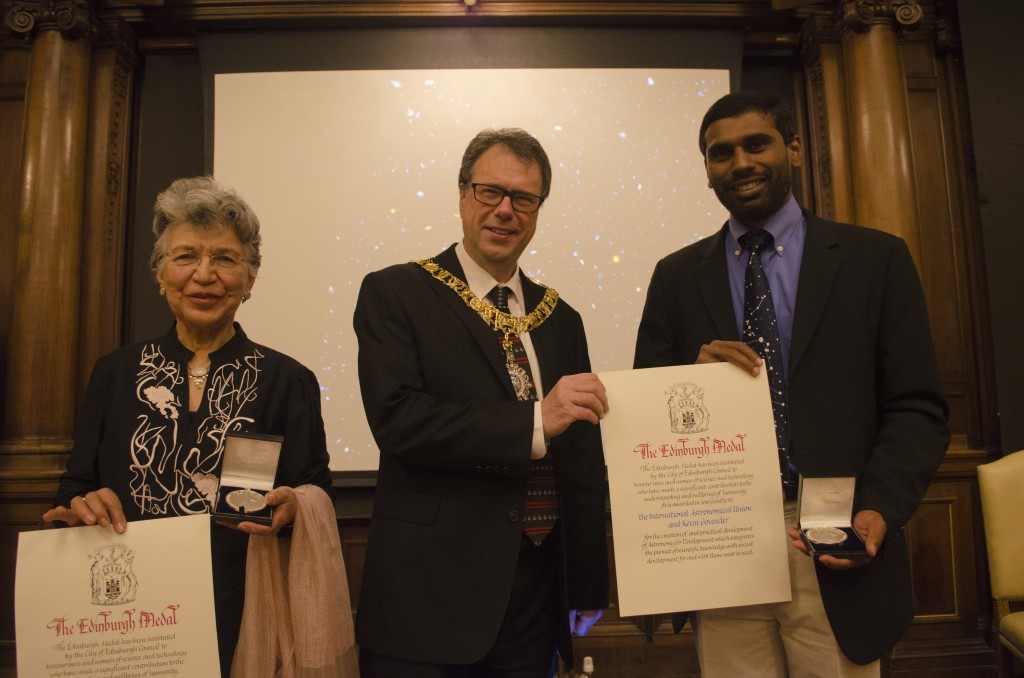On March 30, the 26th Edinburgh Medal ceremony was held at the Edinburgh City Chambers and presided over by the Lord Provost of the city, Donald Wilson. This year, the award was presented jointly to Kevin Govender, director of Office of Astronomy for Development, and Silvia Torres-Piembert, President of the International Astronomical Union.
The Astronomer Royal, Lord Martin Rees, spoke of astronomy as “a vibrant science,” and “the oldest science, except perhaps for medicine – but the first to do more good than harm.” Discussing the achievements of astronomy, space science and cosmology, he recounted human footprints on the Moon, robots on other planets in our solar system and probes landed on comets, and that “we can talk with a straight face about the first microseconds” of the universe, and described Kevin as the driving force of the OAD.
Speaking of the history and goals of the IAU, Silvia told the audience that, founded in 1919, it now has 12,407 members across seventy two countries, actively undertaking the mission of the promotion and safeguarding of the science of astronomy in all its aspects through international co-operation. With 2009 the “international year of astronomy,” it was estimated that 515 million people participated in events across 148 countries.
Discussing the goals of the IAU, she explained that “the quest to explore the universe satisfies the deepest cultural and philosophical yearnings of our species and can stimulate a sense of global citizenship,” and described how astronomy had links to mathematics, physics, chemistry, biology and drove technology and innovation.
Taking the stage, Kevin explained while astronomy was about exploring the universe, the OAD was about “pushing our understanding of our place in the universe,” that “it doesn’t just change a few people in the field, it changes the whole of humanity. This perspective, as enormous as it is, every one of us is capable of understanding it and every one of us is capable of changing our world.”
Having been called “South Africa’s Carl Sagan” by Lord Rees, Kevin took the audience on an animated tour through our galaxy and out beyond the local clusters to the largest structures of the universe before returning to Professor Sagan’s famous “Pale Blue Dot” photo. “We don’t need a migrant crisis to see we are all connected. We don’t need a war to drive innovation. We just need to see the Earth from space. We don’t need to have a global sea level rise and mass destruction. We need the perspective that astronomy gives us.”
Turning to the photo, projected on the back wall of the City Chambers, he invited the audience to consider our feelings were we aliens visiting this solar system, who found that blue planet, teeming with life. “Imagine the excitement. Imagine the hope.”
Speaking of the OAD’s purpose, he said that astronomy would not change the world but people would, and that their goal was to empower people to solve problems, with a focus on inclusiveness, describing the Astrosense project, producing tactile globes of the Moon to allow the visually impaired to understand the geography of other worlds, of a blind woman who analyses astronomical data converted to sound, her contribution beyond gender and disability but in the new perspective she brings to the interpretation.
Kevin spoke of the spirit of his home country and its desire to be at the forefront of research, with projects including the South African Large Telescope (SALT), one of the largest optical telescopes in the world, and the Square Kilometer Array (SKA), the largest capacity radio astronomy project ever conceived. “The structures are set up. Now let’s make use of them. We’re ready to roll out big ideas and big projects. May the exploration of the universe bring us closer to home.”
Closing the evening, Professor Monica Grady gave the vote of thanks, saying “There is very little in life that we get for free, but what we do get for free is a view of the night sky. You may not get the Hubble deep range, but what you will get is something which has inspired humanity for generations.”

